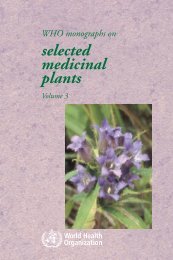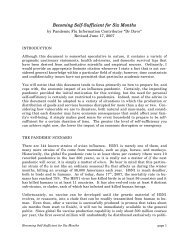You also want an ePaper? Increase the reach of your titles
YUMPU automatically turns print PDFs into web optimized ePapers that Google loves.
COMMON EDIBLE MUSHROOMS<br />
mon as to be rarely or never found, but many a mushroom convicted<br />
as poisonous by any of these tests might well have been<br />
edible and delicious. In fact, it can be stated flatly that no one of<br />
these tests, nor all of them put together, will serve to separate the<br />
poisonous kinds from the edible.<br />
For the proof of the mushroom is in the eating. Some kinds are<br />
known to be edible because people have eaten them without ill<br />
effects, and others are known to be poisonous because when eaten<br />
they have caused illness. In this respect mushrooms do not differ<br />
from other poisonous plants, such as water hemlock and deadly<br />
nightshade. There is no external sign by which we can see that<br />
water hemlock is fatal if eaten, and we know that it is only because<br />
people in the past have been poisoned by it and their survivors<br />
have described the plant accurately enough so that others<br />
might recognize and avoid it. One of our most: generally grown<br />
and delicious of garden vegetables, the tomato, was not commonly<br />
grown in England or America for more than two hundred years<br />
after it had been taken to Europe from South America. Because<br />
of its resemblance to its near relative, the deadly nightshade,<br />
it was considered poisonous and was cultivated only as a botanical<br />
curiosity. Only by eating it did people find out that it was not<br />
poisonous. The same thing is true of mushrooms. Of two that are<br />
closely related one may be poisonous and the other perfectly<br />
wholesome, and only by knowing the distinguishing characters of<br />
each can one separate the good from the bad.<br />
An example will illustrate how subtle this difference sometimes<br />
is. Lepiota morgani is a poisonous mushroom and if eaten causes<br />
severe, though seldom fatal, illness. Lepiota rachodes is edible and<br />
delicious. These two are so closely related and look so much alike<br />
that even an expert can tell them apart only by the fact that mature<br />
specimens of L. morgani, the poisonous one, have green gills<br />
and deposit pale green spores, whereas the spores and gills of<br />
L. rachodes, the edible one, are white. Half-grown specimens of<br />
the two kinds are identical. L. morgani commonly comes up in<br />
the spring, /_,. rachodes in the fall, and people who know them<br />
TO
















